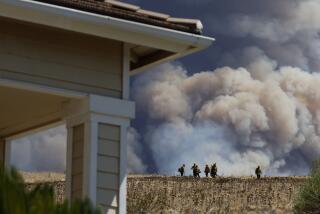Early Fires Worry Birders
TUCSON — Wildlife managers and bird watchers are keeping an anxious eye on the region’s world-famous bird habitat--home to nearly 500 species of birds--as forest fires continue to rage across southeastern Arizona.
Fire crews on Thursday contained a 36,000-acre fire that burned near Fort Huachuca, about 70 miles south of here. That blaze centered on a mountain range containing three canyons that are meccas for bird watchers.
This week’s fire did not do any significant damage to the canyons but one had already been threatened. Ramsey Canyon Preserve, an internationally known destination for birders, was shut down for a week in March because of an early-season wildfire.
With a long-term drought here making fires more likely, experts say bird habitats are in peril because they are often precisely in the path of wildfires--heavily wooded areas.
“If all three canyons were to go, you’re talking about real problems with habitat,” said Carol Lambert, Ramsey Canyon’s manager. Although the 300-acre preserve, operated by the Nature Conservancy, was well fortified against fire, the potential was great for damage to the area’s rare birds, she said.
“Obviously, it’s a pretty scary fire season,” she said. “Chances of a huge fire here are slim, but they are better this year than any time in the last 50 years. And, given the number of rare birds we have here, fire damage would be a great loss.”
Bird watching-related tourism is a boon to the region’s economy, supporting a string of bed and breakfast inns. Bird watchers come from around the world and stay in southeastern Arizona for weeks at a time, making a tour that takes in the Chiricahua Mountains in the east to the Huachuca Mountains and the Santa Rita Mountains in the west.
Birders flock here because of the great variety of birds--many of them rare--and for the region’s surprising biodiversity. Among the seldom-seen birds that have made the region famous: elegant trogons, hepatic tanagers, whiskered screech owls, Arizona woodpeckers, dusky-capped flycatchers and dozens of species of hummingbirds.
Birding is a $15-billion industry in this country, with Arizona and Texas as the top two destinations, said Andy Thompson, publisher of Bird Watcher’s Digest.
“In the minds of most birders, southeast Arizona is certainly in the top two or three bird watching hot spots in the continental United States,” Thompson said. “They’ve got a long history of catering to and addressing and servicing bird watchers. For us, these fires are a difficult thing to witness.”
Experts agree that fire is not necessarily bad and in fact may improve the long-term health of a forest. But the massive, hot fires officials fear would certainly destroy whole forests and bird habitat with it.
Hotter fires happen in areas where fires have not been allowed to burn naturally and dead wood and underbrush pile up.
“The one thing that is worrisome is that because of fire suppression, the fires we do have tend to be extreme. They have the potential to be bigger and more devastating,” said Courtney Conway, an avian ecologist at the University of Arizona. Conway is studying the buff-breasted flycatcher, a rare bird that is believed to fare better in fire-damaged areas.
Low-intensity fire, experts say, will likely benefit birds. Sheri Williamson is a biologist and hummingbird expert at the Southeast Arizona Bird Observatory in Bisbee, which hosts a hummingbird festival every August. She said the fire’s clearing of trees creates meadows, increases the insect population and makes birds happy.
Birds are also more likely to quickly return to a habitat burned by a low-intensity fire, Williamson said.
Mostly, experts say, birds smell smoke and fly away before fires ever reach them. In the case of a devastating fire that destroys vast tracts of habitat, flocks will relocate to the closest suitable place. Succeeding generations may or may not return to the original nesting area once the habitat is restored.
The special concern now is that the fires in Arizona are occurring so early, at the start of nesting season.
Mother birds “won’t leave their young unless, literally, flames are at the trunk of their nesting tree,” Lambert said.
Lambert also manages a bed and breakfast that serves visitors to Ramsey Canyon. She said the inn had to be evacuated during the Oversight Fire in March, which burned to within 11/2 miles of the preserve.
Bird watchers, she said, are constantly monitoring local conditions and bird populations via the Internet. The fires--and fear of them--have been bad for business.
“It’s pretty flat since the fires in March,” Lambert said. “Some people called yesterday to ask about the Ryan fire [in Fort Huachuca] and wanted to know if we were affected. People around here view the preserve as a jewel--it’s important for the local economy. Fires don’t help the birds or us.”
More to Read
Sign up for The Wild
We’ll help you find the best places to hike, bike and run, as well as the perfect silent spots for meditation and yoga.
You may occasionally receive promotional content from the Los Angeles Times.







